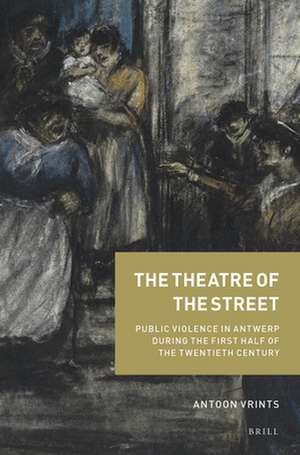The Theatre of the Street: Public Violence in Antwerp During the First Half of the Twentieth Century: Crime and City in History, cartea 2
Autor Antoon Vrintsen Limba Engleză Hardback – 11 dec 2019
Making use of Antwerp police records, Vrints shows that the prevailing discourse on public violence does not pass the test of empirical facts. The presumed correlation between the occurrence of public violence and the decline of neighbourhood life must even be reversed to some extent. The nature of public violence paradoxically points to the crucial importance of neighbourhood networks.
Preț: 674.27 lei
Preț vechi: 822.28 lei
-18% Nou
Puncte Express: 1011
Preț estimativ în valută:
129.02€ • 133.11$ • 107.67£
129.02€ • 133.11$ • 107.67£
Carte indisponibilă temporar
Doresc să fiu notificat când acest titlu va fi disponibil:
Se trimite...
Preluare comenzi: 021 569.72.76
Specificații
ISBN-13: 9789004416925
ISBN-10: 9004416927
Dimensiuni: 155 x 235 mm
Greutate: 0.73 kg
Editura: Brill
Colecția Brill
Seria Crime and City in History
ISBN-10: 9004416927
Dimensiuni: 155 x 235 mm
Greutate: 0.73 kg
Editura: Brill
Colecția Brill
Seria Crime and City in History
Notă biografică
Antoon Vrints, Ph. D. (2006), Ghent University, is Associate Professor of Social History at that university. He has published monographs and many articles on the First World War and on crime and criminal justice history, including De overlevenden. De Belgische oud-strijders tijdens het interbellum (Polis, 2018).
Cuprins
List of Figure and Tables
List of Abbreviations
Introduction
1 A Controversial Issue
2 Violence as a Significant Social Phenomenon
3 The Empirical Basis
4 Structure of This Book
1 Life on a Stage
1.1 Introduction
1.2 A Public Existence
1.3 Openness, Reputation and Reciprocity
1.4 Honour Fights
1.5 Between Self-Regulation and Disciplination by an Outside Agency
1.6 Revenge, Social Standing and Violence
1.7 Violence as a Means of Social Control?
1.8 Domestic Squabbles and Respectability
1.9 Sexual Violence, Shame and Discretion
1.10 Conclusion
2 The Rules of the Game
2.1 Ritual Interaction
2.2 The Power of Language
2.3 Expressive Body Language
2.4 Violation and Defilement
2.5 Territorial Strategies
2.6 The Rules of the Duel
2.7 Conclusion
3 Men’s and Women’s Roles
3.1 Introduction
3.2 Men and Women in Battle
3.3 Men’s and Women’s Language
3.4 Men’s and Women’s Places?
3.5 Conclusion
4 Repertoires of Respectability
4.1 Introduction
4.2 Group-Specific Behavioural Patterns
4.3 Shifts over Time?
4.4 Possible Explanations for Behavioural Shifts
4.5 Conclusion
5 Values behind Words
5.1 Insults, Values and Identification
5.2 The Sexual Reputation of Men and Women
5.3 Purity and Respectability
5.4 The Established and the Outsiders
5.5 About “coward”, “thief” and Other Insults
5.6 Conclusion: Substantive Stability?
General Conclusion
1 Public Violence and Social Ties: a Theatre with a Message and an Audience
2 Public Violence and Social Stratification: Theatre of the Common People
3 Public Violence and Social Meaning: Honour and Shame at Stake
4 Epilogue: Public Violence, from Theatre to Misunderstood Spectacle
Sources and Bibliography
Subjects
Modern Authors
List of Abbreviations
Introduction
1 A Controversial Issue
2 Violence as a Significant Social Phenomenon
3 The Empirical Basis
4 Structure of This Book
1 Life on a Stage
1.1 Introduction
1.2 A Public Existence
1.3 Openness, Reputation and Reciprocity
1.4 Honour Fights
1.5 Between Self-Regulation and Disciplination by an Outside Agency
1.6 Revenge, Social Standing and Violence
1.7 Violence as a Means of Social Control?
1.8 Domestic Squabbles and Respectability
1.9 Sexual Violence, Shame and Discretion
1.10 Conclusion
2 The Rules of the Game
2.1 Ritual Interaction
2.2 The Power of Language
2.3 Expressive Body Language
2.4 Violation and Defilement
2.5 Territorial Strategies
2.6 The Rules of the Duel
2.7 Conclusion
3 Men’s and Women’s Roles
3.1 Introduction
3.2 Men and Women in Battle
3.3 Men’s and Women’s Language
3.4 Men’s and Women’s Places?
3.5 Conclusion
4 Repertoires of Respectability
4.1 Introduction
4.2 Group-Specific Behavioural Patterns
4.3 Shifts over Time?
4.4 Possible Explanations for Behavioural Shifts
4.5 Conclusion
5 Values behind Words
5.1 Insults, Values and Identification
5.2 The Sexual Reputation of Men and Women
5.3 Purity and Respectability
5.4 The Established and the Outsiders
5.5 About “coward”, “thief” and Other Insults
5.6 Conclusion: Substantive Stability?
General Conclusion
1 Public Violence and Social Ties: a Theatre with a Message and an Audience
2 Public Violence and Social Stratification: Theatre of the Common People
3 Public Violence and Social Meaning: Honour and Shame at Stake
4 Epilogue: Public Violence, from Theatre to Misunderstood Spectacle
Sources and Bibliography
Subjects
Modern Authors




